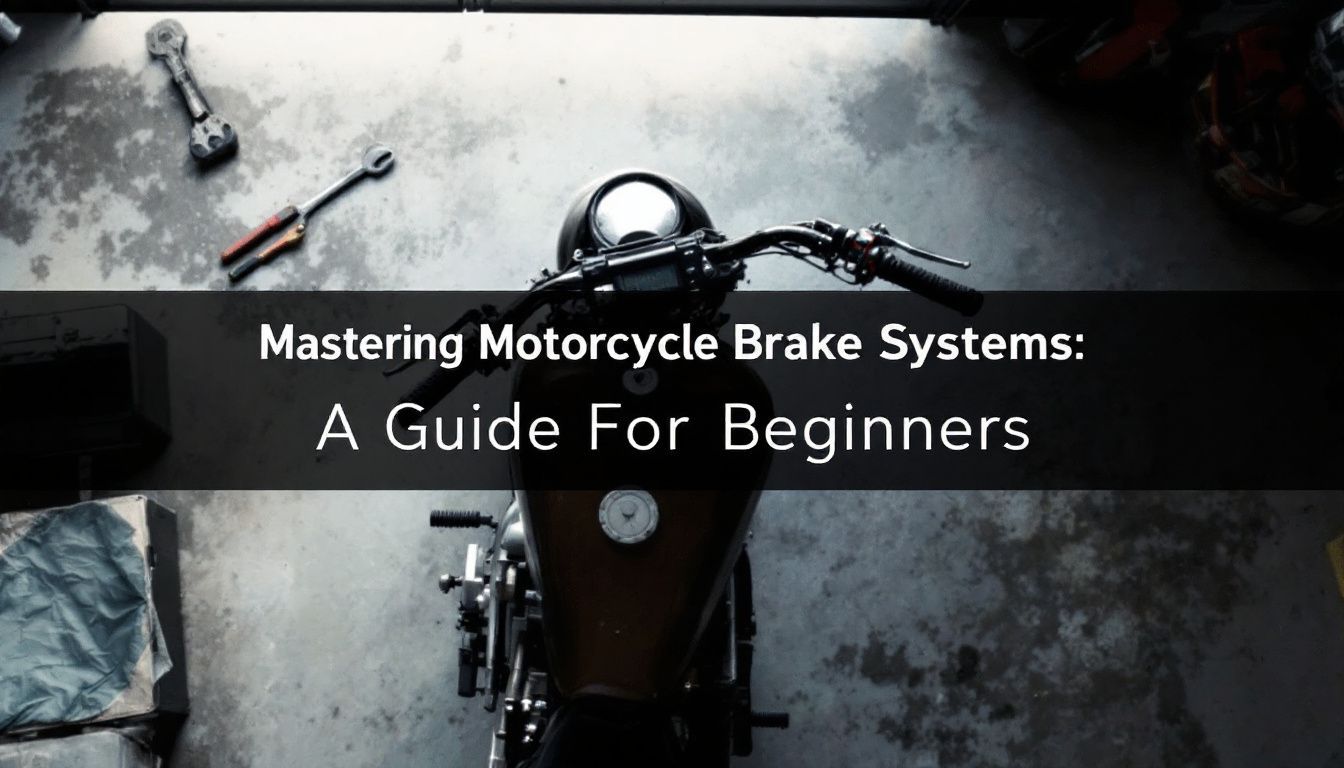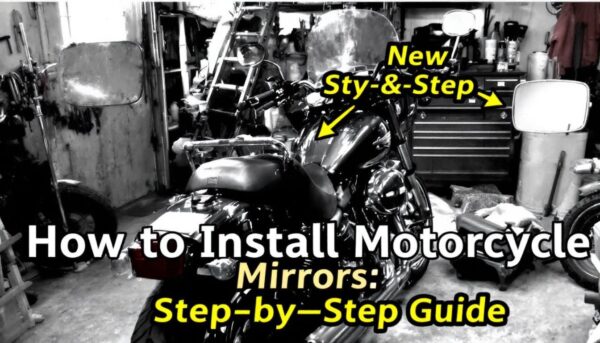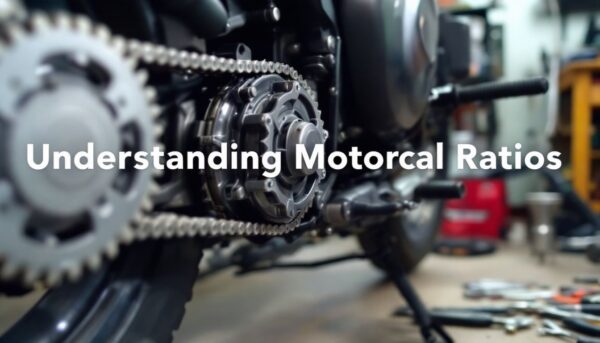
Mastering Motorcycle Brake Systems: A Guide for Beginners
Getting the hang of motorcycle brake systems can be tough for beginners. You might find yourself unsure when to use the front or rear brake, or how hard to press them without skidding.
The key to mastering motorcycle riding lies in understanding and effectively using your bike’s brakes.
One fact you need to know is that proper braking techniques are vital for safety on the road. This guide will teach you all about different motorcycle brake systems and how they work.
You’ll learn tips for slowing down and stopping safely, whether you’re riding in good weather or facing a sudden emergency.
We’ll cover everything from basic braking tips to advanced strategies for high-speed situations. Ready? Let’s get started on mastering your bike’s brakes!
Key Takeaways
- Use both the front and rear brakes together for safe stopping. The front brake has most of the power.
- Practice makes perfect, especially with emergency braking. Try doing drills in a safe place.
- Keep your motorcycle’s brake system well-maintained. Check brake pads and fluid regularly.
- Weather affects how you should use your brakes. Be more careful when it’s wet or icy.
- Learn about your bike’s weight and type of brakes (disc or drum). This helps choose the best braking method for you.
Understanding Motorcycle Brake Systems
Understanding motorcycle brake systems is key for safe riding. You need to know how brakes work and what parts are involved.
The Basics of Motorcycle Braking
Motorcycle braking is key for safety and performance. Knowing how to use your brakes correctly helps you stay in control. There are two main types of brakes: front and rear. Each brake has a role to play when stopping or slowing down.
Using both the front and rear brakes is essential. The front brake provides most of the stopping power, while the rear brake helps balance your motorcycle. Use them together for smooth stops.
Avoid locking up the rear wheel as it can cause you to lose control.
Emergency braking skills are crucial too. This means knowing when and how to stop quickly without falling off your bike. Practising these techniques can make a big difference on the road, especially during unexpected situations.
Key Components of a Brake SystemMastering motorcycle braking systems leads to safer rides.
A motorcycle brake system has key components that work together to ensure safety and control. The main parts include the brake lever, master cylinder, brake lines, calipers, and brake pads.
Each part plays a vital role in slowing down or stopping your bike.
The brake lever is what you pull to activate the brakes. This pulls fluid from the master cylinder through the brake lines. The fluid travels to the calipers where it pushes against the brake pads.
These pads clamp onto the discs or drums to create friction and stop your motorcycle.
Understanding these components helps you maintain your bike better and troubleshoot common issues. Proper maintenance keeps your braking performance optimal on different terrains and weather conditions.
By knowing how each part works, you can ride with confidence and improve your skills in motorcycle braking techniques for beginners.
Types of Brake Systems
Motorcycles have two main types of brake systems: disc brakes and drum brakes. Each type works differently and has its own strengths, which can affect your ride.
Disc vs. Drum Brakes
Choosing the right brake system for your motorcycle depends on various factors, including your riding style and the type of motorcycle you have. Here, we delve into the differences between disc brakes and drum brakes.
| Aspect | Disc Brakes | Drum Brakes |
|---|---|---|
| How they work | Use calipers to squeeze pairs of pads against a disc or rotor to create friction that slows the wheel. | Use brake shoes that press outwards against a rotating drum attached to the wheel. |
| Performance | Offer better stopping power and heat dissipation, making them ideal for high-speed riding and heavy motorcycles. | Less effective in wet conditions and can fade under heavy use, but they’re more affordable and easier to maintain. |
| Maintenance | Require regular checks for pad wear and rotor condition. More complex and can be more costly to repair. | Simpler and generally less expensive to maintain. Brake shoe replacement and drum cleaning are the main tasks. |
| Weather Conditions | Perform well in various weather conditions, including rain and mud. | Can struggle in wet and muddy conditions as the design can trap water and debris, reducing efficiency. |
| Riding Style | Suited for aggressive and high-speed riding due to better heat management and stopping power. | Good for casual riding and lighter, vintage bikes where outright performance is less critical. |
Understanding both systems helps you make informed decisions about your motorcycle’s brake setup. Each type has its benefits depending on your specific needs and riding conditions. Regular practice and proper maintenance ensure optimal braking performance, essential for your safety and others on the road. Mastering the use of your motorcycle’s brakes, whether disc or drum, is a crucial skill for all riders.
Factors to Consider when Choosing a Brake System
When you choose a brake system, think about your riding style and the kind of motorcycle you have. Weather can also play a big part in your choice. The weight of your bike matters too.
Plus, keep in mind how much maintenance you want to do. For more details on this topic, keep reading!
Riding Style
Your riding style greatly influences your braking needs. Different styles require different techniques. For instance, sport riders often brake harder and later than casual riders. They rely on the front brake more for quick stops.
This method helps slow down faster.
Cruiser riders may use a softer touch while braking. Their aim is comfort over speed. Understanding your style will help you choose the right brake system for your motorcycle.
Adjust your technique based on where you ride as well. Urban environments demand quick reactions to traffic conditions. Off-road riding requires smoother, controlled stops to handle rough terrain safely.
Mastering these aspects of motorcycle brakes is crucial for every rider’s safety and enjoyment on the road.
Type of Motorcycle
The type of motorcycle you ride affects how you brake. Different bikes have unique brake systems that change your braking style. For example, sport bikes usually have more powerful brakes than cruisers.
This can make a difference when slowing down on a motorcycle.
Choosing the right brake system also depends on your bike’s weight and riding style. A heavier motorcycle may need stronger brakes for safe handling. Understanding these differences is key to mastering motorcycle braking systems: a beginner’s guide to better safety and performance on the road.
Weather Conditions
Weather can greatly affect your motorcycle’s braking performance. Wet roads can reduce grip. You must be cautious in rain or on ice. Keep a longer distance when braking in these conditions.
Slippery surfaces make it easier to skid if you brake too hard.
Visibility also changes with weather. Fog and heavy rain limit how far you can see ahead. You may need to adjust your speed and braking style as conditions worsen. Riding in hot weather might lead to brake fade due to overheating, so watch for signs of reduced performance.
Understanding the impact of weather helps ensure safety while riding. Crashes often occur during bad weather, making knowledge vital for every rider’s toolkit. Next, consider how your riding style influences brake system choice.
Weight of the Motorcycle
The weight of your motorcycle plays a big role in how well it brakes. Heavier bikes need more force to stop. This means you must apply the brakes with care. Too much pressure can cause instability, especially when braking at high speed.
Lighter motorcycles often respond better to brake input, allowing for quicker stops.
If you ride a heavier bike, use both front and rear brakes effectively. This balanced approach helps distribute the stopping power evenly. It also prevents skidding or losing control on slippery surfaces.
Your riding style matters too; aggressive riders may need to adjust their technique based on their bike’s weight.
Always consider maintenance needs that might arise from your motorcycle’s weight. Heavier models may wear down brake pads faster than lighter ones due to increased strain during braking events.
Proper upkeep ensures safe and effective operation on all rides, no matter the load of your motorbike. Next, let’s explore tips for effective braking on a motorcycle.
Maintenance Requirements
Weight influences how often you need to maintain your brakes. Heavier motorcycles may put more strain on the brake system. Regular checks are key for safety and performance.
Check brake pads regularly. Worn pads reduce stopping power. Replace them as needed to avoid damage to the rotors. Inspect fluid levels too; low levels can affect braking performance.
Change the brake fluid every one to two years.
Clean and adjust your brakes often. Dirt and grime can make brakes less effective. Keep an eye out for leaks in hoses or lines, as this can lead to bigger issues later on. Proper maintenance helps your motorcycle stop safely whenever you hit the road.
Tips for Effective Braking on a Motorcycle
5. Tips for Effective Braking on a Motorcycle: Learn how to brake properly to stay safe and control your bike better. Mastering your braking skills can make a big difference in your ride.
You will find helpful techniques that every rider should know. Keep reading to boost your braking confidence!
The Two-Brake Rule
The Two-Brake Rule is key for safe riding. Always use both the front and rear brakes together. This gives you better control of your motorcycle. Using only one brake can lead to accidents, especially in an emergency.
You should apply the front brake smoothly while using the rear brake lightly. This technique helps slow down your bike without losing balance. Practicing this rule will make you a safer rider on any type of motorcycle.
It’s important to keep practicing so that it becomes second nature during rides or emergencies.
Next, let’s explore harnessing engine braking for added safety and control.
Harnessing Engine Braking
Engine braking is a handy skill for riders. It helps slow down the motorcycle without using the brakes. This method uses the engine’s compression to reduce speed. When you shut off the throttle, the engine slows down.
This action lets you control your bike better in many situations.
Using engine braking has benefits. It reduces wear on your brake pads. It can also help maintain traction on slippery roads. Always combine this technique with regular braking methods for safety, especially at high speeds.
Knowing how and when to use this skill is key for every rider.
Focus on smooth transitions while using engine braking. Keep practicing so it becomes second nature to you as a rider. Mastering these skills will improve your overall control of the motorcycle and enhance your riding experience now and in challenging conditions ahead.
Mastering the Front Brake
Mastering the front brake is crucial for your safety while riding. This brake provides most of a motorcycle’s stopping power. Using it correctly helps you stop quickly and avoid accidents.
Apply the front brake gently. Too much pressure can lock the wheel, causing a skid.
Practice using your front brake in different situations. Start with slow speeds to gain confidence. As you get better, try braking at higher speeds. You should learn when to use it along with the rear brake for balanced stopping power.
Using clutch while braking also matters. Pull in the clutch before applying brakes to prevent stalling, especially when slowing down quickly. Make regular practice part of your routine too; this will keep you sharp and ready for any unexpected events on the road.
Understanding the Rear Brake
The rear brake is crucial for controlling your motorcycle. It helps you slow down smoothly, especially at low speeds. Using the rear brake properly can prevent the front wheel from lifting during hard stops.
This keeps your ride stable and balanced.
Applying the rear brake also assists in cornering. It gives you more control when leaning into turns. Riders must practice using it along with the front brake for better performance and safety on the road.
Make sure to use both brakes together, as this improves stopping power and reduces skidding risks.
Synchronised Braking
Moving from understanding the rear brake, let’s explore synchronised braking. This technique combines both front and rear brakes at the same time. You gain better control of your motorcycle while stopping or slowing down.
Using both brakes helps to distribute the force evenly. This method prevents skidding and keeps you stable. Practicing synchronised braking is crucial for safety, especially during emergency situations.
It allows for smoother stops and reduces wear on your brake components. Mastering this essential motorcycle braking technique will enhance your riding experience greatly.
Regular Practice and Training
Practicing your braking skills is key. Regular practice helps you become a better rider. Make sure to work on your emergency braking. This skill can help you avoid crashes. It tops the list of important control skills every rider should know.
Training also covers techniques for using both front and rear brakes effectively. Knowing when to use each brake will improve your control on the bike. The more you practise, the more comfortable you’ll feel at high speeds too.
Consider taking courses focused on motorcycle braking techniques. These can give you valuable tips and insights from experts. You’ll learn how to slow down safely in different situations, ensuring a safer ride for yourself and others on the road.
Body Dynamics
Body dynamics play a big role in motorcycle braking. Your body position affects how well you can control the bike. Keep your arms relaxed and use them to steer. Lean into turns, and shift your weight when braking.
This helps maintain balance.
Using both brakes effectively means adjusting your body position too. Shift your weight forward when using the front brake. This keeps the bike stable and prevents it from tipping over.
With the rear brake, lean back slightly for better control while slowing down.
Practice good posture every time you ride. Good body dynamics help with emergency braking as well. Stay aware of how your movements impact handling on different surfaces and at various speeds.
Mastering these skills leads to safer rides on any motorcycle.
Emergency Braking Drills
Practicing emergency braking drills is essential for every rider. These drills help you learn to stop quickly and safely during unexpected situations. You want to avoid a crash, so mastering this skill is vital.
To start, find a safe area with plenty of space. Ride at a moderate speed first. Then, practice applying both brakes firmly but smoothly at the same time. This technique helps prevent locking up your wheels.
Focus on keeping control of your motorcycle while stopping fast.
Try these drills often so they become second nature. Remember that emergency braking is the top control skill for avoiding crashes. Regular practice can make all the difference in ensuring your safety on the road while riding your motorcycle.
Advanced Techniques for Sports Bikes
Sports bikes need special braking techniques. Speed makes a big difference in stopping power. Always use both brakes for better control. The front brake is stronger, so apply it carefully to avoid flipping the bike over.
Body position matters too. Lean forward when braking hard to keep the bike stable. Engine braking can help slow you down without using the brakes much. Practice emergency stops often to stay sharp on your skills.
Knowledge of proper motorcycle braking techniques helps ensure safety and performance while riding sports bikes at high speed.
Proper Maintenance for Optimal Braking Performance
Check your brake fluid regularly. Low fluid can lead to poor braking performance. Make sure it is clean and at the right level. Replace old fluid every 1-2 years. This helps keep your brakes working well.
Inspect brake pads often. Worn-out pads can hurt stopping power. Change them when they are too thin. It’s a simple task that keeps you safe on the road.
Look for leaks in the brake lines and hoses. Cracks or holes can cause loss of pressure, which affects braking ability. Tighten loose connections as needed, and replace any damaged parts quickly to maintain optimal braking performance while riding your motorcycle safely.
Conclusion
Mastering your motorcycle’s brake system is key for safe riding. You learned about different types of brakes and their parts. Good braking techniques can keep you in control, especially at high speeds.
Practice these tips regularly to build confidence. Enjoy your rides and stay safe out there!
FAQs
1. What is the purpose of mastering motorcycle brake systems for beginners?
Mastering motorcycle brake systems helps beginners learn essential braking techniques, understand when to use front and rear brakes, and how to slow down a bike at high speed.
2. Can you provide some motorcycle braking tips for beginners?
Sure! Beginners should practice using both front and rear brakes together, get comfortable with using the clutch while braking, and learn how to identify the front brake on their motorcycles.
3. How do I brake on a motorcycle at high speed?
To safely brake at high speeds, apply both your front and rear brakes smoothly without slamming them. Using the clutch while braking can also help control your speed.
4. When should I use the front brake on my motorcycle?
The front brake provides most of your stopping power so it’s important to use it whenever you need to slow down or stop quickly. However, always remember that abrupt usage can cause an accident.
5. Any specific tips for using the rear brake on a motorbike?
Yes! The rear brake is great for controlling speed in corners or during low-speed manoeuvres but might not be as effective as the front one during high-speed stops.


